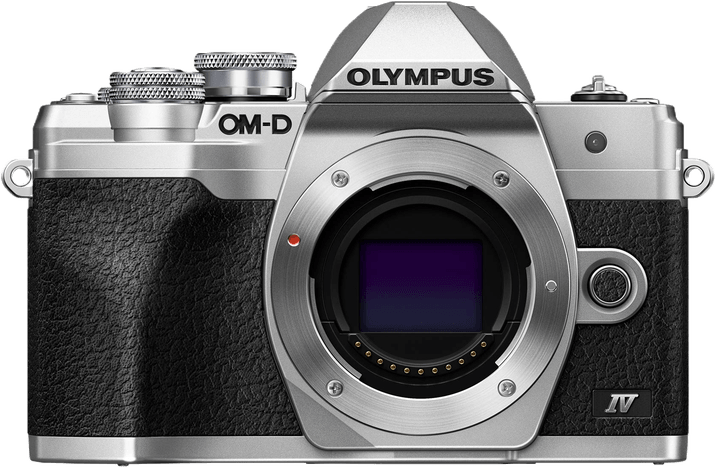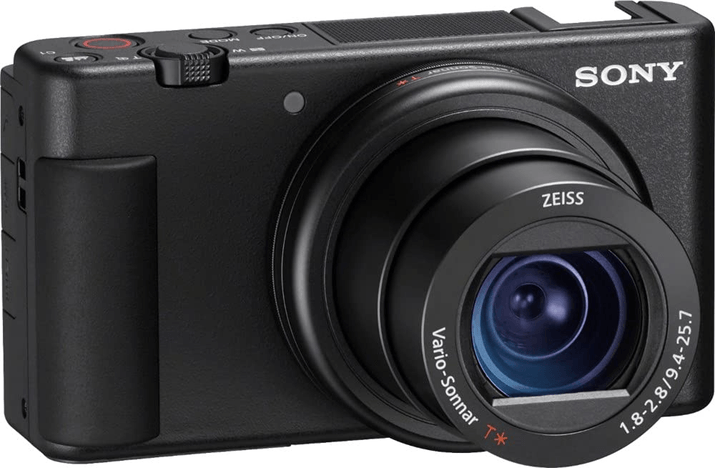Olympus OM-D E-M10 Mark IV vs Sony ZV-1 Comparison
Olympus OM-D E-M10 Mark IV

Sony ZV-1

The Sony ZV-1 edges out the Olympus OM-D E-M10 Mark IV with a score of 65/100 compared to 63/100. Both cameras share a 2020 release year and are from reputable brands. They differ in camera type, with the Olympus being a mirrorless camera and the Sony a compact camera.
The Olympus OM-D E-M10 Mark IV is slightly heavier at 383g and larger at 122 x 84 x 49mm, giving it a more substantial feel. Its launch price is also lower at $699. On the other hand, the Sony ZV-1 is lighter and more compact, weighing 294g with dimensions of 105 x 60 x 44mm, making it more portable. However, it comes with a higher launch price of $800.
While both cameras have their advantages, the Sony ZV-1’s higher score reflects its better overall performance and features. The Olympus OM-D E-M10 Mark IV offers a more affordable option with a solid build, but the Sony ZV-1 stands out as the top choice due to its compact size and superior performance.
Olympus OM-D E-M10 Mark IV vs Sony ZV-1 Overview and Optics
The Sony ZV-1 prevails over the Olympus OM-D E-M10 Mark IV in optics with a score of 67/100, a difference of 4 points. Both cameras share common specifications, including 20-megapixel resolution, CMOS sensor, image stabilization, and shooting speed. However, the differences in their performance and features determine the winner.
The Sony ZV-1 outperforms the Olympus OM-D E-M10 Mark IV with its faster shooting speed of 24, compared to 15. Additionally, its DXOMARK sensor score is higher at 82, while the Olympus scores 73. The ZV-1 also has a larger 1″ sensor size and a 3:2 aspect ratio. These factors contribute to the Sony ZV-1’s superior optics performance.
On the other hand, the Olympus OM-D E-M10 Mark IV has its own advantages. It features a Micro Four Thirds sensor size and a lens mount compatible with Micro 4/3 lenses, allowing for lens interchangeability. The Olympus camera also has a 4:3 aspect ratio and a TruePic VIII processor. Despite these strengths, they are not enough to surpass the Sony ZV-1’s overall optics performance.
Comparing the optics of both cameras, the Sony ZV-1 emerges as the winner due to its higher performance in shooting speed, sensor score, sensor size, and aspect ratio. Meanwhile, the Olympus OM-D E-M10 Mark IV offers lens interchangeability as its advantage. However, it falls short in outperforming the Sony ZV-1 in terms of optics quality.
Olympus OM-D E-M10 Mark IV vs Sony ZV-1 Video Performance
The Sony ZV-1 outperforms the Olympus OM-D E-M10 Mark IV in video capabilities, with a score of 91/100 compared to the Olympus’ 83/100. Both cameras share some similar specifications, such as 4K max video resolution and 3840 x 2160 max video dimensions. They also both have built-in time-lapse functionality.
The Sony ZV-1 takes the lead in video performance due to its higher max video frame rate of 120fps, compared to the Olympus’ 60fps. This allows the Sony ZV-1 to capture smoother and more detailed slow-motion footage, making it an ideal choice for videographers who require versatility and precision in their work.
While the Olympus OM-D E-M10 Mark IV falls short in comparison to the Sony ZV-1 in terms of video capabilities, it still offers respectable performance for its category. With a max video frame rate of 60fps, it is suitable for casual video recording and can still produce quality footage for various applications.
To sum up, the Sony ZV-1 is the superior choice for video recording, offering a higher video score and a significantly faster max video frame rate. This makes it ideal for professionals and enthusiasts who prioritize video capabilities. On the other hand, the Olympus OM-D E-M10 Mark IV is a decent option for those who are not as focused on video performance but still require a reliable camera for casual video recording.
Olympus OM-D E-M10 Mark IV vs Sony ZV-1 Features and Benefits
The Olympus OM-D E-M10 Mark IV outperforms the Sony ZV-1 in the features category, scoring 70/100 compared to the Sony ZV-1’s 68/100. Both cameras share several specifications, including a 3-inch touchscreen, flip screen, and the absence of GPS. Additionally, they both possess WiFi and Bluetooth capabilities.
The Olympus OM-D E-M10 Mark IV surpasses the Sony ZV-1 in screen resolution, offering 1,040,000 dots compared to the ZV-1’s 921,600 dots. This higher resolution provides sharper and clearer image previews, allowing for better composition and review of captured images. The two-point advantage in the feature score reflects this superiority in screen resolution.
Despite its lower overall feature score, the Sony ZV-1 still has its merits. It is important to note that the difference in scores is minimal, and the shared specifications between the two cameras emphasize their similarities. The Sony ZV-1’s strengths may lie in other areas not covered by the feature score, such as video capabilities or lens options.
Taking into account the close scores and shared specifications, both cameras offer a solid set of features. The Olympus OM-D E-M10 Mark IV edges out the Sony ZV-1 due to its higher screen resolution, which enhances image preview and review. However, the Sony ZV-1 remains a strong contender, especially when considering factors beyond the features category. Ultimately, the choice between these two cameras will depend on individual preferences and priorities in other aspects of camera performance.
Olympus OM-D E-M10 Mark IV vs Sony ZV-1 Storage and Battery
The Olympus OM-D E-M10 Mark IV outperforms the Sony ZV-1 in storage and battery with a score of 35/100 versus the ZV-1’s 29/100. Both cameras share similarities such as having one memory card slot and accepting SD/SDHC/SDXC cards. Additionally, they both offer USB charging capabilities.
The E-M10 Mark IV excels with its battery life, providing 360 shots compared to the ZV-1’s 260 shots. This longer battery life makes the E-M10 Mark IV more suitable for extended photography sessions. The camera also supports UHS-II compatible cards, which allows for faster read and write speeds.
On the other hand, the Sony ZV-1 accepts Memory Stick Pro Duo and Pro-HG Duo cards, providing an additional storage option for users who may already own these cards. However, the shorter battery life may limit its usability during prolonged shoots.
Ultimately, the Olympus OM-D E-M10 Mark IV is the superior choice in terms of storage and battery life, while the Sony ZV-1 offers an extra memory card compatibility.
Olympus OM-D E-M10 Mark IV vs Sony ZV-1 – Our Verdict
Are you still undecided about which camera is right for you? Have a look at these popular comparisons that feature the Olympus OM-D E-M10 Mark IV or the Sony ZV-1:

